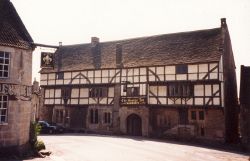Roadside Inn
| Roadside Inn | |
 | |
| The George Inn on the B3110 in Somerset | |
| Pictures related to Roadside Inn View gallery (39) | |
The term Roadside Inn may not be in common use, but it is used here to cover a vast range of buildings which can be found up and down our country, and which served a huge variety of purposes in the past, and in different formats, continue to do so today.
Inns
The earliest Inns we know today date back centuries, almost certainly back into the Saxon period, and had their origins in the Roman period, if not earlier still. They were normally little more than ordinary houses which were open to travellers on a commercial basis, offering food, drink, hospitality and a bed for the night, although then as now there was a great gulf between the best and worst such premises. Such Inns survived in the more rural areas into the Victorian era, and some might argue that a handful still operate today.
Many of the early travellers diaries record visits to Inns, and describe a huge variety of experiences found within. From overcrowding, and sharing beds with strangers in houses where the only food is stale bread, to generous meals and large beds in individual rooms, it is often difficult to spot any patterns in these records, indeed different travellers have recorded very different experiences at the same premises in the space of a few years. Inns were normally found in most villages of any size, and often at regular intervals along the busier roads, allowing travellers to walk or ride from one to the next in the space of a day. Many also served as the local pub, while others were more akin to a guest house or bed and breakfast property of today.
Coaching Inns
As the Turnpike era progressed, so the speed with which travellers could cross the country increased. The origins of coaching inns date back centuries, but it was only as the roads improved and the speed of the coaches increased that the necessity for changing horses every 10 or so miles arose, thus requiring coaching inns along the major routes, and subsequently many lesser routes too. These Coaching inns would be substantial establishments, with large stables and the facility to provide refreshments for the coach travellers in a very short space of time.
Horses were generally changed every hour - approximately 10 or 12 miles - and only worked once a day for 3 days out of 4, on average. The horses normally just worked one section of road, back and forth, although sometimes they would be swapped about. Therefore, on the busier coaching routes stables would need to be able to attend to several teams of horses all at the same time, whether owned by the Inns (neighbouring inns reciprocating in looking after each others horses) or the coaching companies. Private individuals would also be able to hire horses, whether for riding or pulling their own carts or coaches, and just as now with hire cars, one-way hires could be arranged.
As cars replaced horses, many of the old coaching inns found themselves with large stable yards that were no longer of much use. If they were sited next to the inn, along the road (as opposed to behind, accessed via an archway), they were often converted into garages where cars could be repaired, refuelled and so on, so maintaining the tradition of offering a full service to the travelling public. This 'all under one roof' philosophy remains today with Motorway Service Stations. Other enterprising innkeepers used the stable yards for parking, extra accommodation or in later years beer gardens and a whole range of other uses.
Ferry Inns
Another common type of Inn serving travellers was the Ferry Inn. Ever since the dawn of the motoring age, and for many years before, we have been used to crossing bridges over rivers and estuaries, but there are still some inland waters which have ferry services. Due to the historical difficulties in getting boats to cross in poor weather, most ferry sites developed Inns where travellers could wait for the ferry to be able to cross. Many of these survived the replacement of the ferry by a bridge, and still thrive today.
Kingshouses
The Kingshouse was unique to the military road network in the Scottish Highlands. The new roads built across vast empty landscapes also required places where travellers could rest - the rank and file soldiers were expected to make camps, but their superiors would use the inns, as would private travellers. A small number of Kingshouses built as part of the road network are known:
- A82 Kingshouse in Glencoe
- A82 Letterfindlay on the shores of Loch Lochy
- A84 Kingshouse at Balquiddher
- Corrieyairack Pass Kingshouse at Garva Mhor
- B862 Former Kingshouse (rebuilt) at Whitebridge
There were doubtless more, including one believed to have stood on the military road now followed by the A887 / A87 route past Cluanie and down Glen Shiel, although the exact location has not been located. Some other Inns have also been referred to as Kingshouses, although most seem to have been private establishments cashing in on the name.
Motels
Moving forward a couple of centuries to the motor age, the term Motel is often though of in relation to American Road movies with their chalet type bedsit rooms attached to a rowdy bar, or perhaps the British Crossroads sitcom. British motels were perhaps a little more sedate than their American cousins, but nevertheless existed for many years before the modern replacements appeared. These are, of course, the ubiquitous Premier Inns, Travelodges and their ilk which are found at motorway service stations, major junctions and city centres up and down the country. They still perform the same basic function as the Inns of old, albeit in a much more anonymous manner.






